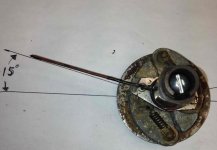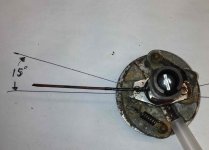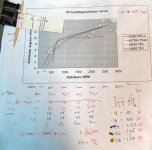TexasKnucklehead
Jedi Knight
Offline
TR3 timing: Ping versus Instrumental
Numerous times I have heard someone ask for the proper method to set engine timing on a TR3. Generally, the most accepted answer is to set it statically at 4 degrees BTDC, then warm it up and advance the timing until it “pings” and then back off a few degrees. I found this method confusing and was unable to satisfy my idea of “properly timed”. Either I am not hearing the ping, or I am not doing it properly. After trying that approach, my engine either performed terribly or ran so hot it could melt the bushing out of the generator. I was reminded of the difference between a “gauge” and an “instrument”. I wanted to use an instrument and know it was timed accurately.
All my distributors are of the original DM2 type. If I remove the breaker plate, the points rotor and advance spring weights, I can see 15 degrees stamped on the lower plate. That is the maximum advance possible from the mechanical advance given in distributor degrees (same as cam degrees since it is driven from the cam but ½ of crankshaft degrees since the crank rotates twice per cam rotation). I was unsure if this marking was crankshaft degrees, or distributor degrees, or if it had been modified, so I made a “gauge”. I used a protractor, marked a sheet of paper with 15 degrees, punched a hole in the center, and slid the shaft with weights into the center. The deflection allowed by the weights moving without the shaft moving is 15 degrees. The Lucas DM2 spec shows full advance occurs by 2700 RPM (cam?). The Tachometer shows engine (crankshaft) RPM (Revolutions Per Minute) –even though it is actually driven from the distributor.
I picked up a fancy timing light from a discount tool store. It included a numbered knob to allow one to ‘dial in’ timing advance. That tool proved to be a gauge, not an instrument. (The ‘dialing in’ caused inconsistent, erroneous, unusual and unbelievable behavior.) Anyone using a timing light attempts to set the timing at idle. If you cross reference the Lucas advance chart, you can see that being off as little as 100 RPM will cause a few degrees of timing error. Couple that with the fact that at low RPMs, a change in RPM will affect the mechanical advance (timing), as well as any change in the timing will affect the engine RPM. This can be a frustrating adjustment.
Still, I wanted to know what advance I was running at engine idle speed. The dash mounted tachometer is a gauge (not an instrument). At idle, the needle is bouncing so that I can’t tell the engine speed within a few hundred RPMs –let alone the possible accuracy of the measurement. I attached my O-scope (a calibrated instrument) to the minus side of the coil, and accurately measured the time between 2 sparks at 39mS (.039 seconds). The time between sparks is ¼ of a complete cam rotation. There are 60 seconds in a minute. Time per rotation needs inverted (1/x) to be the same unit as the tachometer, revolutions per time. The result needs multiplied by 2, since cam rotation is twice crank rotation. So, 39mS X4 /60 INV x2 = 769RPM. Simplified, RPM=30/t. With this formula and instrument, I could accurately set the timing at idle. Each time I look at that formula, I hear Bob Dylan “and revolution in the air”.
I hope much more time is spent with the engine running above the curve of the advance, and think this is the place to concentrate. Knowing full advance occurs at 2,700 RPM. And knowing the 5.5” crank pulley has a hole at TDC, I calculated 30 (2 x 15 max distributor) degrees to be 1.44”. I cut a slit on a piece of paper 1.44” from the edge and used this “gauge” to paint a red mark on the crank pulley to indicate full advance. The timing light at any RPM over 1350 shows the pointer mark at max advance. If not, it takes a simple rotation of the distributor to get the TR3 perfectly timed. Allowing the engine to rev down to idle shows the pointer somewhere between TDC and MAX advance. I can quantify idle speed, and advance, but it doesn’t matter since I do not intend to change the advance curve characteristics.
My “gauge” is how it runs. It accelerates very well, and is no longer running hot (I will leave the discussion of the temperature “gauge” for another time).
My questions are, if I was supposed to set the static timing at 4 degrees, should my max be 30, or 34 degrees? My Haynes manual, under ignition system, says max advance in crank shaft degrees is 15. How can that be? My distributor vacuum unit does not leak, but I can’t find a way to see it change advance. The same manual indicates max vacuum advance of 8 degrees. How/where should I see that? I have a pair of H6S (short) installed which has a single vacuum port in the top of the forward carb, and in front of the throttle plate (air filter side). I can’t feel it sucking, but that’s where I have the advance line connected. A few months ago, I drove home from Baton Rouge and calculated better than 30 miles per gallon.
The more I understand, the more I know I don't understand.
Numerous times I have heard someone ask for the proper method to set engine timing on a TR3. Generally, the most accepted answer is to set it statically at 4 degrees BTDC, then warm it up and advance the timing until it “pings” and then back off a few degrees. I found this method confusing and was unable to satisfy my idea of “properly timed”. Either I am not hearing the ping, or I am not doing it properly. After trying that approach, my engine either performed terribly or ran so hot it could melt the bushing out of the generator. I was reminded of the difference between a “gauge” and an “instrument”. I wanted to use an instrument and know it was timed accurately.
All my distributors are of the original DM2 type. If I remove the breaker plate, the points rotor and advance spring weights, I can see 15 degrees stamped on the lower plate. That is the maximum advance possible from the mechanical advance given in distributor degrees (same as cam degrees since it is driven from the cam but ½ of crankshaft degrees since the crank rotates twice per cam rotation). I was unsure if this marking was crankshaft degrees, or distributor degrees, or if it had been modified, so I made a “gauge”. I used a protractor, marked a sheet of paper with 15 degrees, punched a hole in the center, and slid the shaft with weights into the center. The deflection allowed by the weights moving without the shaft moving is 15 degrees. The Lucas DM2 spec shows full advance occurs by 2700 RPM (cam?). The Tachometer shows engine (crankshaft) RPM (Revolutions Per Minute) –even though it is actually driven from the distributor.
I picked up a fancy timing light from a discount tool store. It included a numbered knob to allow one to ‘dial in’ timing advance. That tool proved to be a gauge, not an instrument. (The ‘dialing in’ caused inconsistent, erroneous, unusual and unbelievable behavior.) Anyone using a timing light attempts to set the timing at idle. If you cross reference the Lucas advance chart, you can see that being off as little as 100 RPM will cause a few degrees of timing error. Couple that with the fact that at low RPMs, a change in RPM will affect the mechanical advance (timing), as well as any change in the timing will affect the engine RPM. This can be a frustrating adjustment.
Still, I wanted to know what advance I was running at engine idle speed. The dash mounted tachometer is a gauge (not an instrument). At idle, the needle is bouncing so that I can’t tell the engine speed within a few hundred RPMs –let alone the possible accuracy of the measurement. I attached my O-scope (a calibrated instrument) to the minus side of the coil, and accurately measured the time between 2 sparks at 39mS (.039 seconds). The time between sparks is ¼ of a complete cam rotation. There are 60 seconds in a minute. Time per rotation needs inverted (1/x) to be the same unit as the tachometer, revolutions per time. The result needs multiplied by 2, since cam rotation is twice crank rotation. So, 39mS X4 /60 INV x2 = 769RPM. Simplified, RPM=30/t. With this formula and instrument, I could accurately set the timing at idle. Each time I look at that formula, I hear Bob Dylan “and revolution in the air”.
I hope much more time is spent with the engine running above the curve of the advance, and think this is the place to concentrate. Knowing full advance occurs at 2,700 RPM. And knowing the 5.5” crank pulley has a hole at TDC, I calculated 30 (2 x 15 max distributor) degrees to be 1.44”. I cut a slit on a piece of paper 1.44” from the edge and used this “gauge” to paint a red mark on the crank pulley to indicate full advance. The timing light at any RPM over 1350 shows the pointer mark at max advance. If not, it takes a simple rotation of the distributor to get the TR3 perfectly timed. Allowing the engine to rev down to idle shows the pointer somewhere between TDC and MAX advance. I can quantify idle speed, and advance, but it doesn’t matter since I do not intend to change the advance curve characteristics.
My “gauge” is how it runs. It accelerates very well, and is no longer running hot (I will leave the discussion of the temperature “gauge” for another time).
My questions are, if I was supposed to set the static timing at 4 degrees, should my max be 30, or 34 degrees? My Haynes manual, under ignition system, says max advance in crank shaft degrees is 15. How can that be? My distributor vacuum unit does not leak, but I can’t find a way to see it change advance. The same manual indicates max vacuum advance of 8 degrees. How/where should I see that? I have a pair of H6S (short) installed which has a single vacuum port in the top of the forward carb, and in front of the throttle plate (air filter side). I can’t feel it sucking, but that’s where I have the advance line connected. A few months ago, I drove home from Baton Rouge and calculated better than 30 miles per gallon.
The more I understand, the more I know I don't understand.

 Hey there Guest!
Hey there Guest!
 smilie in place of the real @
smilie in place of the real @
 Pretty Please - add it to our Events forum(s) and add to the calendar! >>
Pretty Please - add it to our Events forum(s) and add to the calendar! >> 



 A friendly reminder - be careful what links you click on here. If a link is posted by someone you don't know, or the URL looks fishy, DON'T CLICK. Spammers sometimes post links that lead to sites that can infect your computer, so be mindful what you click.
A friendly reminder - be careful what links you click on here. If a link is posted by someone you don't know, or the URL looks fishy, DON'T CLICK. Spammers sometimes post links that lead to sites that can infect your computer, so be mindful what you click.